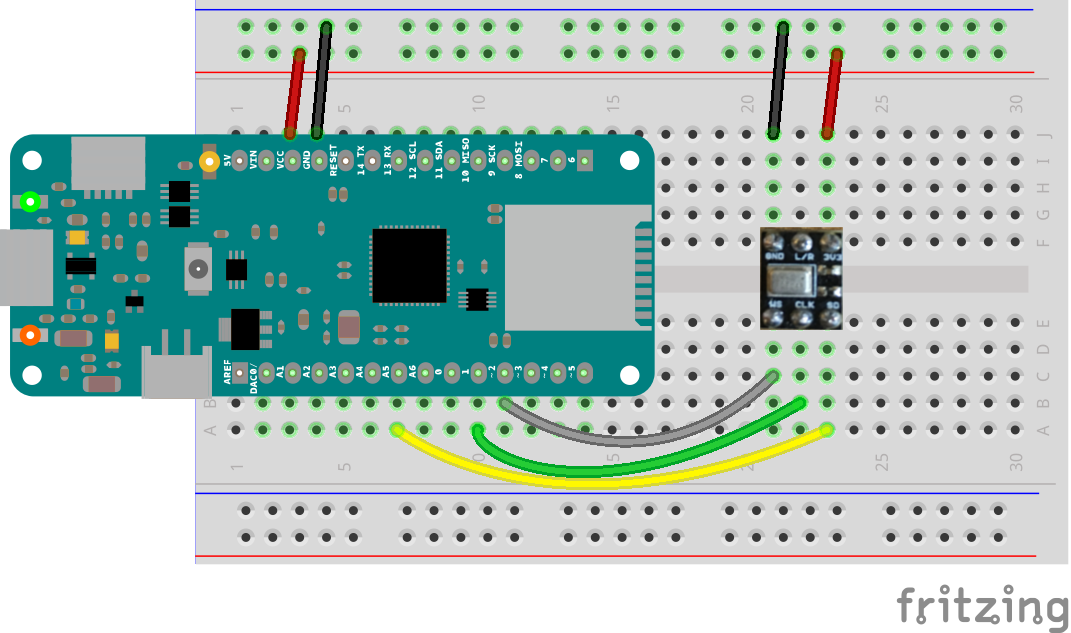Clap Detector
This example reads audio data from an Invensense's ICS43432 I2S microphone breakout board, and uses the input to detect clapping sounds. The built-in LED is togggled when a clapp is detected.
Hardware Required
- Arduino or Genuino Zero, MKRZero or MKR1000 Board
- Invensense's ICS43432 I2S microphone
Circuit
image developed using Fritzing. For more circuit examples, see the Fritzing project page
Code
This example reads audio data from an Invensense's ICS43432 I2S microphone
breakout board, and uses the input to detect clapping sounds. An LED is
togggled when a clapp is detected.
Circuit:
* Arduino/Genuino Zero, MKRZero or MKR1000 board
* ICS43432:
* GND connected GND
* 3.3V connected 3.3V (Zero) or VCC (MKR1000, MKRZero)
* WS connected to pin 0 (Zero) or pin 3 (MKR1000, MKRZero)
* CLK connected to pin 1 (Zero) or pin 2 (MKR1000, MKRZero)
* SD connected to pin 9 (Zero) or pin A6 (MKR1000, MKRZero)
created 18 November 2016
by Sandeep Mistry
*/
#include <ArduinoSound.h>
// the LED pin to use as output
const int ledPin = LED_BUILTIN;
// the amplitude threshold for a clap to be detected
const int amplitudeDeltaThreshold = 100000000;
// create an amplitude analyzer to be used with the I2S input
AmplitudeAnalyzer amplitudeAnalyzer;
// variable to keep track of last amplitude
int lastAmplitude = 0;
void setup() {
// setup the serial
Serial.begin(9600);
// configure the LED pin as an output
pinMode(ledPin, OUTPUT);
// setup the I2S audio input for 44.1 kHz with 32-bits per sample
if (!AudioInI2S.begin(44100, 32)) {
Serial.println("Failed to initialize I2S input!");
while (1); // do nothing
}
// configure the I2S input as the input for the amplitude analyzer
if (!amplitudeAnalyzer.input(AudioInI2S)) {
Serial.println("Failed to set amplitude analyzer input!");
while (1); // do nothing
}
}
void loop() {
// check if a new analysis is available
if (amplitudeAnalyzer.available()) {
// read the new amplitude
int amplitude = amplitudeAnalyzer.read();
// find the difference between the new amplitude and the last
int delta = amplitude - lastAmplitude;
// check if the difference is larger than the threshold
if (delta > amplitudeDeltaThreshold) {
// a clap was detected
Serial.println("clap detected");
// toggle the LED
digitalWrite(ledPin, !digitalRead(ledPin));
// delay a bit to debounce
delay(100);
}
// update the last amplitude with the new amplitude
lastAmplitude = amplitude;
}
}
See Also:
- Arduino Sound library – Your reference for the Arduino Sound Library
- MKR1000 – Product details for the MKR1000 board
- MKRZero – Product details for the MKRZero board
- AmplitudeSerialPlotter : Visualize an audio input on the serial plotter
- SpectrumSerialPlotter : Visualize an audio input spectrum on the serial plotter
- WavePlayback : Reproduce and audio file from SD
- WhistleDetector : Detects your own whistle
Last revision 2016/12/06 by AG

